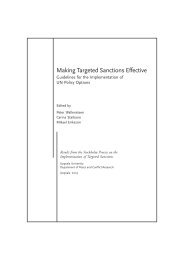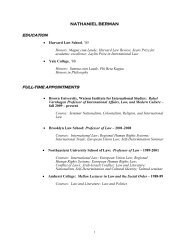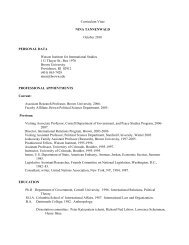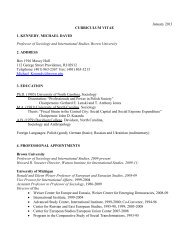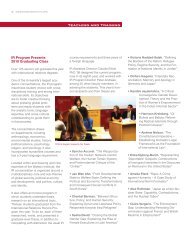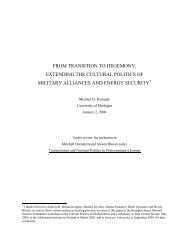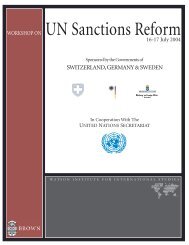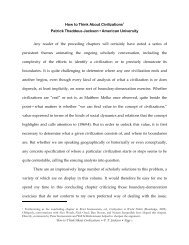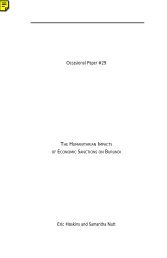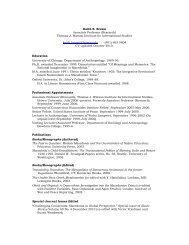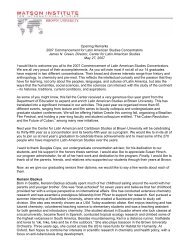op 18 front pages-converted - The Watson Institute for International ...
op 18 front pages-converted - The Watson Institute for International ...
op 18 front pages-converted - The Watson Institute for International ...
Create successful ePaper yourself
Turn your PDF publications into a flip-book with our unique Google optimized e-Paper software.
sons <strong>for</strong>ced to flee intolerable circumstances. Created in 1951,<br />
UNHCR became custodian of the Refugee Convention of that<br />
year and of a later 1967 Protocol. <strong>The</strong> organization’s two<br />
primary functions were “the protection of refugees and the<br />
seeking of durable solutions to their problems.”<br />
Throughout its history, UNHCR’s focus had been on<br />
persons who, <strong>for</strong> reasons of well-founded fear of persecution,<br />
had crossed international borders. More recently, UNHCR<br />
also had been called upon to assist persons displaced within<br />
their own countries of origin. In the current crisis, its constituency<br />
included refugees of all ethnic backgrounds who had fled<br />
the <strong>for</strong>mer Yugoslavia across newly drawn borders as well as<br />
persons in refugee-like situations displaced within those borders.<br />
As it charted its course between international revulsion<br />
against ethnic cleansing and the rights of persons to seek<br />
asylum, UNHCR was caught in a vice. Governments that<br />
traditionally had provided refugees with asylum conveyed<br />
their unwillingness to play their accustomed roles, while<br />
governments in the region were pressing <strong>for</strong> U.N. support of<br />
their own special agendas. One aid official recalls a conversation<br />
with a senior Croatian government representative during<br />
a period of heavy Muslim refugee influx who wanted U.N.<br />
help to remove from Croatia the entire Muslim refugee p<strong>op</strong>ulation.<br />
UNHCR initially sought to discourage ethnic cleansing by<br />
protecting and assisting pe<strong>op</strong>le where they were. In a paper<br />
<strong>for</strong> an international meeting in July 1992, UNHCR emphasized<br />
the need “to prevent and contain displacement.” A<br />
strategy of preventive protection was recommended, entailing<br />
“such activities as monitoring of the treatment of ethnic<br />
minority groups, mediation between parties, exposure of the<br />
practice of <strong>for</strong>ced relocation and other measures to improve<br />
respect <strong>for</strong> human rights and humanitarian law.”<br />
Meanwhile, an internal UNHCR Working Group was<br />
reviewing challenges, in the <strong>for</strong>mer Yugoslavia and elsewhere,<br />
to the traditional protection concept. Its report affirmed<br />
asylum as a fundamental principle of refugee protection<br />
and urged UNHCR to “continue to promote the right of all<br />
refugees to seek and enjoy asylum, at least on a temporary<br />
65



